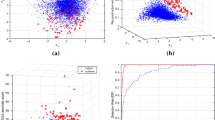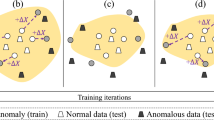Abstract
Novelty detection (ND) is a crucial task in machine learning to identify anomalies in the test data in some respects different from the training data. As an anomaly detection method, novelty detection only uses normal samples for model learning, which can well fit most of the natural scenes that the amount of abnormal samples is in fact strongly insufficient, such as network intrusion detection, industrial fault detection, and so on, due to the rareness of abnormal events or the high cost of abnormal samples collection. This paper proposes a reconstruction-based ND scheme by introducing an optimized deep generative model (ODGM), which combines the concept of Variational Auto-encoder (VAE) and the generative adversarial network (GAN) model jointly to efficiently and stably learn the essential characteristics from normal samples. A novelty index is established by combining signal reconstruction loss and feature loss between the original signal of the reconstructed signal based on the ODGM on normal samples for anomaly point identification in the test data. The effectiveness and superiority of the proposed model is validated and compared with other representative deep learning-based novelty detection models on two public data sets.
Access this chapter
Tax calculation will be finalised at checkout
Purchases are for personal use only
Similar content being viewed by others
References
Ming, Z.A., Tong, L., Rui, Z., et al.: Conditional Wasserstein generative adversarial network-gradient penalty-based approach to alleviating imbalanced data classification. Inf. Sci. 512, 1009–1023 (2020)
Su, C.T., Hsiao, Y.H.: An evaluation of the robustness of MTS for imbalanced data. IEEE Trans. Knowl. Data Eng. 19(10), 1321–1332 (2007)
Zhu, H., Liu, G., Zhou, M., et al.: Optimizing weighted extreme learning machines for imbalanced classification and application to credit card fraud detection. Neurocomputing 407, 50–62 (2020)
Liu, J., Wang, J., Liu, X., et al.: Mwrspca: online fault monitoring based on moving window recursive sparse principal component analysis. J. Intell. Manufact. (2021). Early Access: https://doi.org/10.1007/S10845-10020-01721-10848
Liu, J., Zhang, W., Ma, T., et al.: Toward security monitoring of industrial cyber-physical systems via hierarchically distributed intrusion detection. Exp. Syst. Appl., 158, 113578(113571–113523) (2020)
Liu, J., Zhang, W., Tang, Z., et al.: Adaptive intrusion detection via GA-GOGMM-based pattern learning with fuzzy rough set-based attribute selection. Exp. Syst. Appl. 139(1), 112845(112841–112817) (2020)
Domingues, R., Michiardi, P., Barlet, J., et al.: A comparative evaluation of novelty detection algorithms for discrete sequences. Artif. Intell. Rev. 53(2), 3787–3812 (2020)
Liu, J., Liu, H., Gong, S., et al.: Automated cardiac segmentation of cross-modal medical images using unsupervised multi-domain adaptation and spatial neural attention structure. Med. Image Anal. 72(August), 102135 (2021)
Hodge, V.J., Austin, J.: A survey of outlier detection methodologies. Artif. Intell. Rev. 22(2), 85–126 (2004)
Pimentel, M., Clifton, D.A., Lei, C., et al.: A review of novelty detection. Signal Process. 99(6), 215–249 (2014)
Ke, Y., Yao, C., Song, E., et al.: An early fault diagnosis method of common-rail injector based on improved CYCBD and hierarchical fluctuation dispersion entropy. Dig. Signal Proc. 114(4), 103049 (2021)
Lei, A.C., Clifton. D.A., Watkinson, P., et al.: Identification of patient deterioration in vital-sign data using one-class support vector machines; In: Proceedings of The Federated Conference on Computer Science and Information Systems - Fedcsis 2011, Szczecin, Poland, 18–21 September 2011, Proceedings, F (2011)
Beghi, A., Cecchinato, L., Corazzol, C., Rampazzo, M., Simmini, F., Susto, G.A.: A one-class SVM based tool for machine learning novelty detection in HVAC chiller systems. IFAC Proceedings Volumes 47(3), 1953–1958 (2014). https://doi.org/10.3182/20140824-6-ZA-1003.02382
Jyothsna, V., Tirupati, A.R., Prasad, V.V.R., et al.: A review of anomaly based intrusion detection systems. Int. J. Comput. Appl. 28(7), 26–35 (2013)
Liu, J., He, J., Zhang, W., et al.: Anid-seokelm: adaptive network intrusion detection based on selective ensemble of kernel ELMS with random features. Knowl.-Based Syst. 177(1), 104–116 (2019)
Hassani, A., Iranmanesh, A., Mansouri, N.: Text mining using nonnegative matrix factorization and latent semantic analysis. Neural Comput. Appl. 154, 107121 (2021)
Dieter, O., Benoit, D.F., Phlippe, B.: From one-class to two-class classification by incorporating expert knowledge: novelty detection in human behaviour - Sciencedirect. European J. Operat. Res. 282(3), 1011–1024 (2020)
Clifton, L., Clifton, D.A., Zhang, Y., et al.: Probabilistic novelty detection with support vector machines. IEEE Trans. Reliab. 63(2), 455–467 (2014)
Silva, S.R., Vieira, T., Martínez, D., Paiva, A.: On novelty detection for multi-class classification using non-linear metric learning. Exp. Syst. Appl. 167, 114193 (2021)
Górski, J., Jaboński, A., Heesch, M., Dziendzikowski, M., Dworakowski, Z.: Comparison of novelty detection methods for detection of various rotary machinery faults Sensors 21(10), 3536 (2021)
Sun, K.: Information-theoretic data injection attacks on the smart grid. IEEE Trans. Smart Grid 11(2), 1276–1285 (2020)
Vasilev, A., et al.: Q-space novelty detection with variational autoencoders. In: Bonet-Carne, E., Hutter, J., Palombo, M., Pizzolato, M., Sepehrband, F., Zhang, F. (eds.) Computational Diffusion MRI. MV, pp. 113–124. Springer, Cham (2020). https://doi.org/10.1007/978-3-030-52893-5_10
Han, M., Ozdenizci, O., Wang, Y., et al.: Disentangled adversarial autoencoder for subject-invariant physiological feature extraction. IEEE Signal Process. Lett. 27, 1565–1569 (2020)
Simão, M., Neto, P., Gibaru, O.: Improving novelty detection with generative adversarial networks on hand gesture data. Neurocomputing 358, 437–445 (2019)
Cho. J.A.A.S.: Variational Autoencoder Based Anomaly Detection Using Reconstruction Probability. SNU Data Mining Center (2015)
Larsen, A.B.L., Snderby S.K.H.L.: Autoencoding Beyond Pixels Using A Learned Similarity Mmetric. ICML. (2016)
Xie, R., Jan, N.M., Hao, K., et al.: Supervised variational autoencoders for soft sensor modelling with missing data. IEEE Trans. Industr. Inf. 16(4), 2820–2828 (2020)
Kim, Y., Alnujaim, I., Daegun, O.: Human activity classification based on point clouds measured by millimeter wave MIMO radar with deep recurrent neural networks. IEEE Sens. J. 21(12), 13522–13529 (2021)
Liu, J., He, J., Xie, Y., et al.: Illumination-invariant flotation froth color measuring via Wasserstein distance-based cycleGAN with structure-preserving constraint. IEEE Trans. Cybern. 51(2), 2168–2275 (2021)
Goodfellow, I.J., Pouget-Abadie, J., Mirza, M., et al.: Generative adversarial networks. Adv. Neural. Inf. Process. Syst. 3, 2672–2680 (2014)
Chen, X., Kingma, D. P, Salimans, T., et al.: Variat. Lossy Autoencoder (2016)
Wolterink, J.M., Leiner, T., Viergever, M.A., et al.: Generative adversarial networks for noise reduction in low-dose Ct. IEEE Trans. Med. Imaging 36(12), 2536–2545 (2017)
Schlegl, T., Seeböck, P., Waldstein, S.M., Schmidt-Erfurth, U., Langs, G.: Unsupervised anomaly detection with generative adversarial networks to guide marker discovery. In: Niethammer, M., Styner, M., Aylward, S., Zhu, H., Oguz, I., Yap, P.-T., Shen, D. (eds.) Information Processing In Medical Imaging, pp. 146–157. Springer International Publishing, Cham (2017). https://doi.org/10.1007/978-3-319-59050-9_12
Tavallaee, M., Bagheri, E., Lu, W., et al.: A detailed analysis of the Kdd Cup 99 data set. In: Proceedings of the 2009 IEEE Symposium on Computational Intelligence for Security and Defense Applications, F, pp. 8–10 July 2009 (2009)
Acknowledgements
This work was supported by the national natural science foundation of China under grant No.61971188 and 61771492, in part by the Scientific Research Project of Hunan Education Department under grant No.19B364.
Author information
Authors and Affiliations
Editor information
Editors and Affiliations
Rights and permissions
Copyright information
© 2022 Springer Nature Singapore Pte Ltd.
About this paper
Cite this paper
Liu, L., Liu, J., Wu, J., Zhou, J., Cai, M. (2022). Novelty Detection-Based Automated Anomaly Identification via Optimized Deep Generative Model. In: Liao, X., et al. Big Data. BigData 2021. Communications in Computer and Information Science, vol 1496. Springer, Singapore. https://doi.org/10.1007/978-981-16-9709-8_9
Download citation
DOI: https://doi.org/10.1007/978-981-16-9709-8_9
Published:
Publisher Name: Springer, Singapore
Print ISBN: 978-981-16-9708-1
Online ISBN: 978-981-16-9709-8
eBook Packages: Computer ScienceComputer Science (R0)





